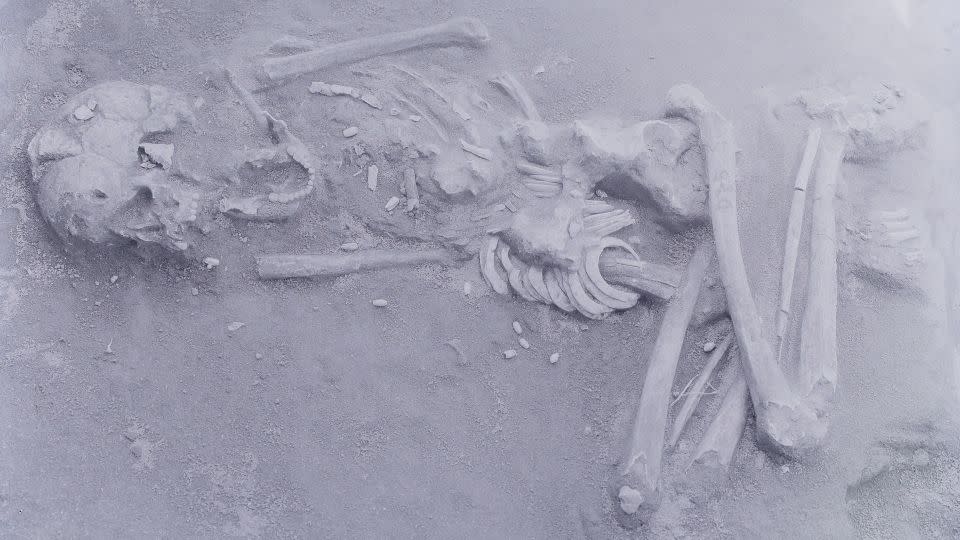Long-standing mystery of modified human skulls in ancient Japan solved by new analysis
Sign up for CNN’s Wonder Theory science newsletter. Explore the universe with news on fascinating discoveries, scientific advancements and more.
Modified skulls found in an ancient burial site in Japan were deliberately reshaped in both men and women as an expression of collective identity. The practice may also have helped the group to forge trade connections, a new study suggests.
In all the skulls, the normally rounded part at the back of the head was flattened and squared off, possibly through binding or being pressed against a flat surface during infancy.
The skulls belonged to individuals from the Hirota people, who lived on the southern Japanese island of Tanegashima from the third century to the seventh century. They were buried at a large grave site that was first excavated in the 1950s and then later in the early 2000s, researchers reported Wednesday in the journal PLOS One. The site held hundreds of skeletons, and 90% of the burials were richly adorned with glass beads and pendants, bracelets and beads made of shell, suggesting that all the burials held people of similar status.
The study team determined that Hirota people practiced cranial deformation “regardless of social rank or sex,” said coauthors Dr. Noriko Seguchi, an associate professor with the Faculty of Social and Cultural Studies at Kyushu University in Japan, and James Frances Loftus III, a postdoctoral research fellow at the university.
Shells adorning Hirota remains were abundant but were not local to the region. The artifacts originated thousands of kilometers south of the burial site, suggesting that Hirota people traded for them. It’s possible, the researchers suggested, that the Hirota cranial reshaping played a part in their trading success.
“We hypothesize that the Hirota people deformed their crania to preserve group identity and potentially facilitate long-distance trade of shellfish, as supported by archaeological evidence,” Seguchi and Loftus told CNN in an email.
An ancient and widespread practice
Intentional skull reshaping is found in burials across Asia, Europe and Mesoamerica. Modified skulls from medieval sites in Germany and Croatia show signs of deformation, and an elongated skull from China that’s 12,000 years old suggests that such modifications date to Neolithic times.
The practice was also widespread among the Maya in Central America and what is now Mexico, prior to the arrival of Europeans. Cranial deformation in Mayan people is particularly well documented, with carved figurines showing children wearing devices to shape their skulls, “such as a board on the forehead,” Seguchi and Loftus said. “This could have been a practice done by mothers or caretakers of infants as young as a couple of weeks or months old.”
Other researchers had previously speculated about the flattened Hirota skulls in Japan, but it was unknown whether the Hirota modifications were deliberate or merely a byproduct of other cultural practices.
For the new study, the scientists 3D-scanned and digitally modeled 19 adult Hirota skulls to conduct more detailed morphological analysis. The team compared them to adult skulls from two other ancient Japanese groups — Jomon and Doigahama.

“We examined abnormalities in cranial sutures that might have formed during growth and development by utilizing a novel 3D visualization method of cranial surfaces,” Seguchi and Loftus explained. This new technique revealed an unprecedented level of detail in subtle bone shapes.
READ MORE: 300,000-year-old skull found in China unlike any early human seen before In all three groups, male and female skulls were deformed. But in the Hirota skulls, the occipital region — a cranial bone at the back — was notably flatter than in Jomon and Doigahama skulls. Certain indentations were also identified in Hirota skulls but were absent in those of Jomon and Doigahama individuals. These depressions may have been left by binding practices that deformed the infant skulls, the scientists said.
Intentionally modified skulls
In the Hirota skulls, the occipital region — a cranial bone at the back — was notably flatter than in Jomon and Doigahama skulls.
The dramatic flatness of Hirota crania, the skull depressions and overall changes in bone structure corresponded with examples of extreme skull modification in cultures from the Americas. This told the researchers that Hirota people also deliberately modified their cranial shapes.

The authors are hopeful that future excavations may uncover settlements that offer further evidence of the Hirota people’s daily lives, which will shed light on their motivations for cranial deformation.
“Through these findings, we believe we have begun the process of unravelling the still mysterious nature of the Hirota people, their culture, and potential trade practices,” Seguchi and Loftus said. “We hope that this study will open the eyes of researchers of this and other periods of Japanese prehistory to lines of thinking which allow us to view Japan through an international lens, seeing cultural practice as a fluid and changing phenomenon.”
Correction: A previous version of this story incorrectly stated that the Jomon and Doigahama groups had crainial deformations.
For more CNN news and newsletters create an account at CNN.com

